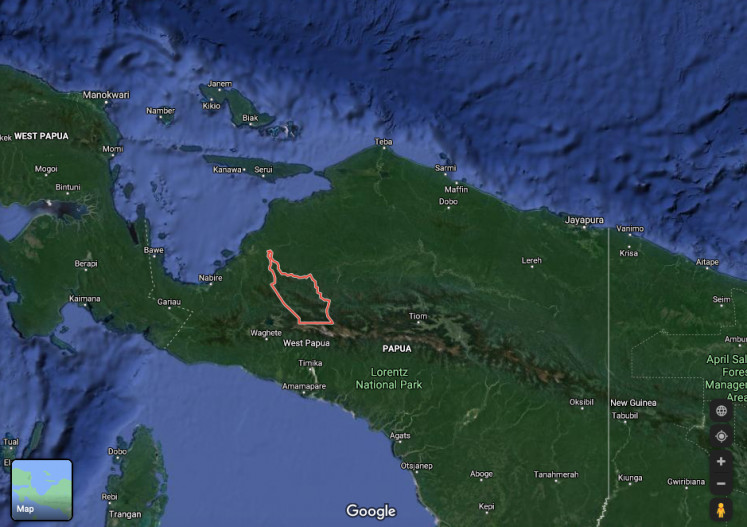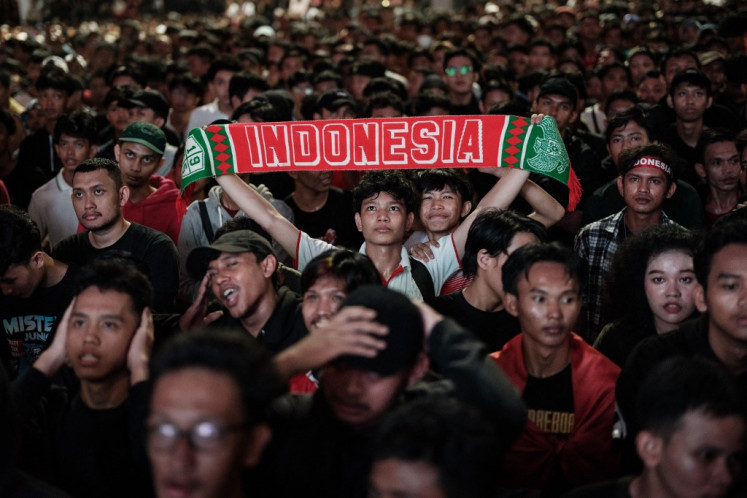Bright Young Things
Jakarta’s indie fashion market has taken off to a new level as young Indonesians have become more connected to international trends and are more willing to experiment against the mainstream with alternative designs
Change text size
Gift Premium Articles
to Anyone

J
akarta’s indie fashion market has taken off to a new level as young Indonesians have become more connected to international trends and are more willing to experiment against the mainstream with alternative designs.
As the movement has grown over recent years and trends have taken their hold, the shelf space offering support for young designers to kick-start their labels, has grown exponentially.
Chris Kerrigan of The Goods Dept in Plaza Indonesia shopping mall said growth of the local fashion market has reached an exciting stage.
“It is actually getting bigger and bigger, it is really exciting. When you are talking about London, New York, or places like that, you are at the bottom of a giant barrel and it is really crazy when you start off there. But here… you have the chance to make your own opportunities,” he says.
Prior to opening The Goods Dept, known as the hub for alternative fashion and lifestyle products from independent Indonesian designers and international brands, Kerrigan founded the Brightspot market, an initiative that aimed to take advantage of empty-mall space to showcase independent designs.
For an event with such humble beginnings — “to help out friends make great stuff” — as Kerrigan described it, the market can arguably now be seen as the stepping stone between bedroom market stalls to premier mall stalls; the real birth of local labels, including Cotton Ink, a Goods Dept top seller.
“After joining Brightspot, Cotton Ink has just kept growing and growing — it has even been winning some awards lately.”
The market, which began in April 2009 with 25 vendors and 5,000 shoppers, did not take long to attract a cult following, with the final market — held in The Goods Dept current location — drawing 65 vendors and more than 40,000 shoppers over four days.
Looking back, Kerrigan said he could only describe this growing demand as real market encouragement for design school graduates to push their fresh and exciting new designs out of their sketch books and into production.
“There are a lot of really talented people in Jakarta. They’re really innovative and continue to come up with great products. There are also a lot of people who are hungry for something new.”
Following on with the success of the market atmosphere, The Goods Dept was opened two months ago as an industrial warehouse space to appeal to young shoppers as a haven away from the bright lighting and highly structured space of most malls.
“We just want people to walk in and feel like they are stepping out of the mall,” Kerrigan said.
Cotton Ink designers, Carline Darjanto and Ria Sarwono, who started their jersey basics brand to earn some extra pocket money as students, were awarded Best Innovative Local Brand in the Cleo Fashion Awards at Jakarta Fashion Week last year.
They said their success had come not only from their creations at affordable pieces, but from the growing use of social media among the country’s youth that had led them to be more connected to international trends and interests, particularly indie, boutique fashion.
“Young people these days are more aware of fashion because that can easily get information about it on the Internet,” Carline said.
Friends since high school, the duo — who describe their brand as basic and casual with a twist — said they saw the growth of the independent market as a sign that youth were joining a growing movement that finds labels outside the mainstream as entirely acceptable, a feeling that is relatively new to the malls of Jakarta.
“I want everybody to wear our clothes, not just the people with gorgeous bodies. Everybody has to feel comfortable with themselves, not the brand,” Carline said.
Petite Cupcakes takes ideas from the small, simple things that surround them every day to produce personalized lines of clothing. Courtesy of Petit Cupcakes
Looking forward, the Cotton Ink girls can only dream the market will continue in a direction that will support the opening of their own stores.
“I hope that the local brand thing is not just a trend and it will keep growing. We don’t want people buying our clothes just because it is a trend, we want every local brand to grow bigger and sit alongside Topshop and Zara,” Carline said.
Carline, who studied at LaSalle Fashion College, said this was most certainly possible, as interest in fashion design as a career option for secondary school graduates expanded.
LaSalle Fashion School spokesman, Douwes Lasmana, agreed with Carline that enrolments had increased exponentially with market growth. “Yes, we have great interest in our courses,” he said.
Petite Cupcakes designers, also LaSalle graduates, said the growth of the industry was sign of the development of Jakarta’s youth movement -- a movement away from the mainstream and popular, and toward more the alternative, multicultural trends — also evident in the growth of fixed gear bikes and the independent film and music scene.
“I think that the youth are becoming more and more fashion conscious and fashion forward. They are now using fashion as a medium to express themselves, as their self-identity,” Cherries Budiman, one of the trio, said.
Petite Cupcakes started with a mindset similar to the growing movement they described — a desire to make something that suited their own style, rather than the style of mannequins in shiny malls
“We always found it difficult to get affordable clothes that could match our style. We were always fascinated by vintage and felt there weren’t too many options available in Jakarta to feed our appetite for modern, yet vintage inspired clothes,” Cherries said.
Rather than drawing inspiration from runway shows in fashion capitals, the Petite Cupcakes trio said it was more important for them to take ideas from the small, simple things that surround them every day, in order to produce lines of clothing that are personalized to the small niche market for vintage in Jakarta.
“The [ideas come from] the simplest things, from old photographs to my niece’s wooden tricycle. This season, it was a teal journal we found lying on a patchwork blanket in a shop window. We like to travel back in time a little bit, to our mums’ era, by bringing fun patterns and shapes mixed with pretty and feminine details,” Cherries said.
According to Petite Cupcake, mainstream styles are not the recipe for success, but rather fresh styles, motivated graduates and a supportive industry — all of which Jakarta has.
“I think the fashion industry here in Indonesia is really moving forward. And what is more amazing is that today, we as young designers feel really supported by many fashion events and media coverage,” Cherries said “All this really helps us in creating a platform to present our work to a bigger audience.”
Febriarnita Christy of Oneandahalf Clothing, a brand that sells in The Goods Department, said the presence of young fashion designers had grown in Jakarta in recent years, with young fashion lovers, mostly those coming from middle class economy, having no restrictions on fashion spending.
“Most of them do not care about prices. If they like the products and love the quality, they’ll buy them,” she says.
The trend is good news for young designers, allowing them to showcase their works.
“By wearing the creations of local designers, it’s a big support for us,” she says.









